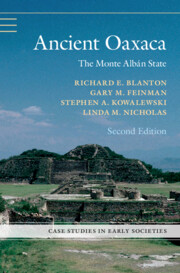Book contents
- Ancient Oaxaca
- Case Studies in Early Societies
- Ancient Oaxaca
- Copyright page
- Contents
- Figures
- Preface to the Second Edition
- 1 Introduction: Mesoamerica and Its Pre-Hispanic Civilization
- 2 Theorizing Sociocultural Evolution
- 3 Before Monte Albán
- 4 Origins of Monte Albán
- 5 The Great Transformation
- 6 Thinking About Theories of Sociocultural Evolution from the Perspective of Oaxaca
- 7 Cooperation and the Foundation of Monte Albán
- Epilogue
- Bibliographical Essay
- Bibliography
- Index
1 - Introduction: Mesoamerica and Its Pre-Hispanic Civilization
Published online by Cambridge University Press: 07 July 2022
- Ancient Oaxaca
- Case Studies in Early Societies
- Ancient Oaxaca
- Copyright page
- Contents
- Figures
- Preface to the Second Edition
- 1 Introduction: Mesoamerica and Its Pre-Hispanic Civilization
- 2 Theorizing Sociocultural Evolution
- 3 Before Monte Albán
- 4 Origins of Monte Albán
- 5 The Great Transformation
- 6 Thinking About Theories of Sociocultural Evolution from the Perspective of Oaxaca
- 7 Cooperation and the Foundation of Monte Albán
- Epilogue
- Bibliographical Essay
- Bibliography
- Index
Summary
The objective of Ancient Oaxaca is to understand and account for the sudden appearance of a new city on a mountain, Monte Albán, about 500 BC, and the consequences of that event, which in the following few centuries would transform almost every aspect of cultural life. These developments in the Valley of Oaxaca region were part of and contributed to the creation of the sociocultural formations that characterized the world system or civilization of Mesoamerica.
Information
- Type
- Chapter
- Information
- Ancient OaxacaThe Monte Albán State, pp. 1 - 20Publisher: Cambridge University PressPrint publication year: 2022
